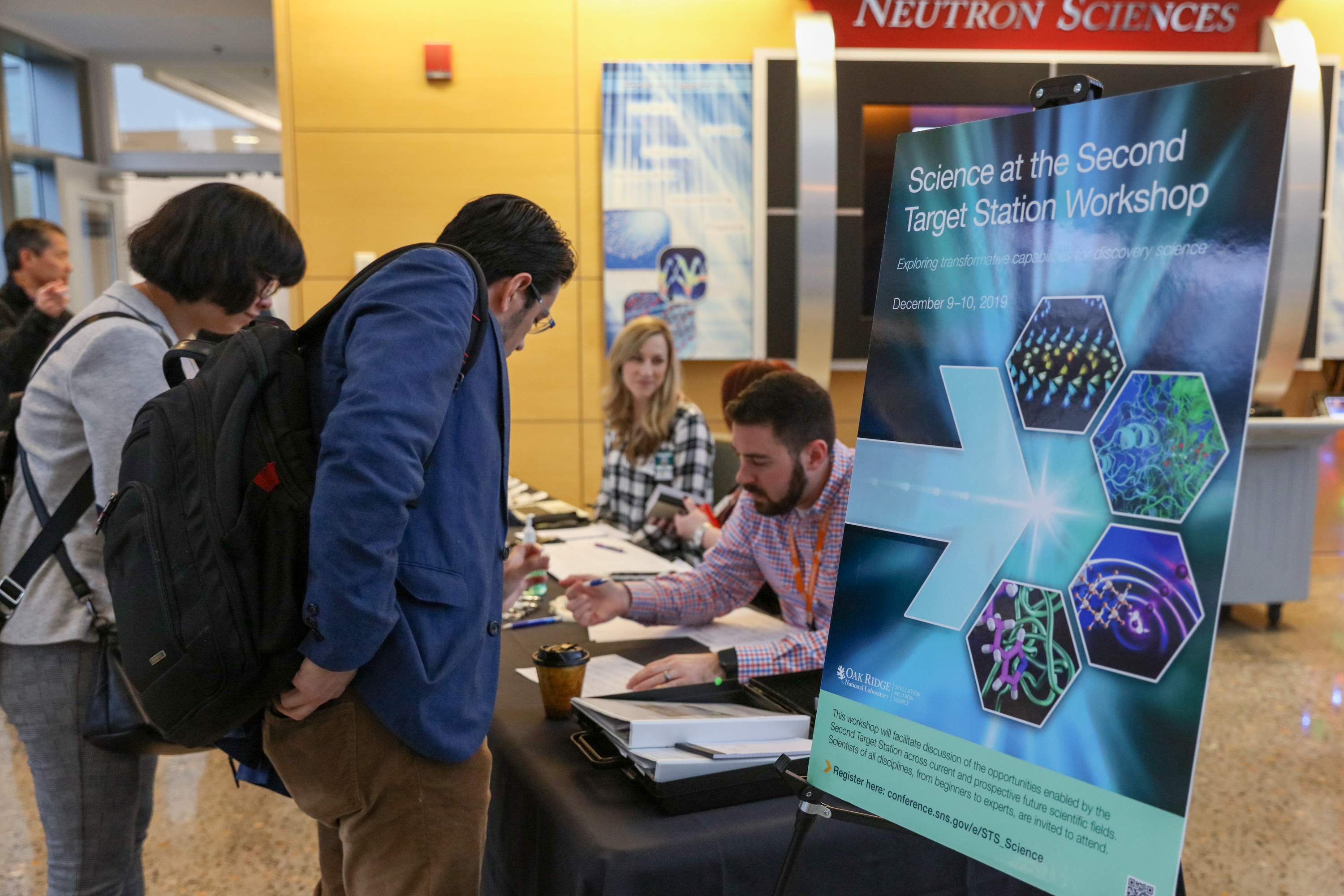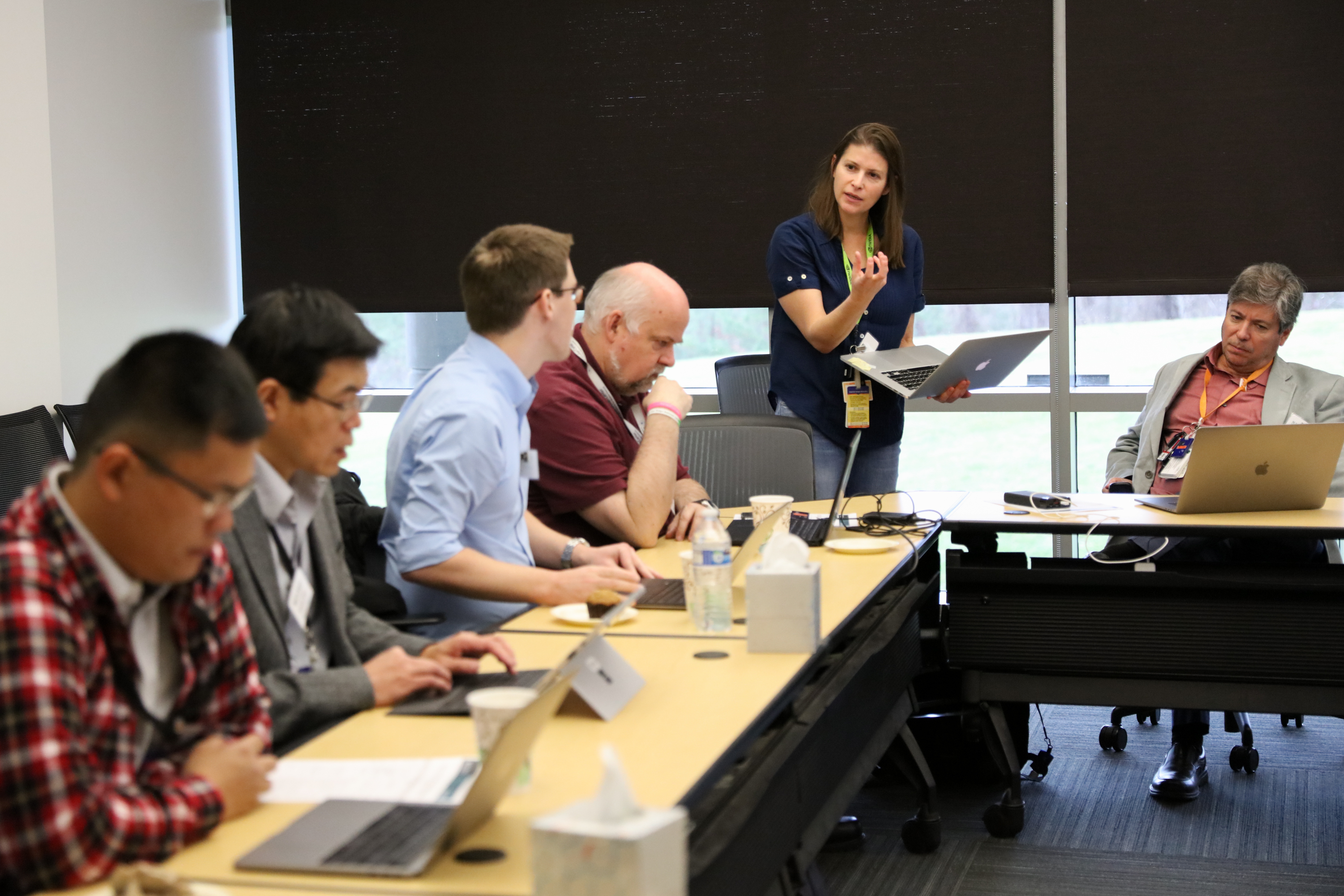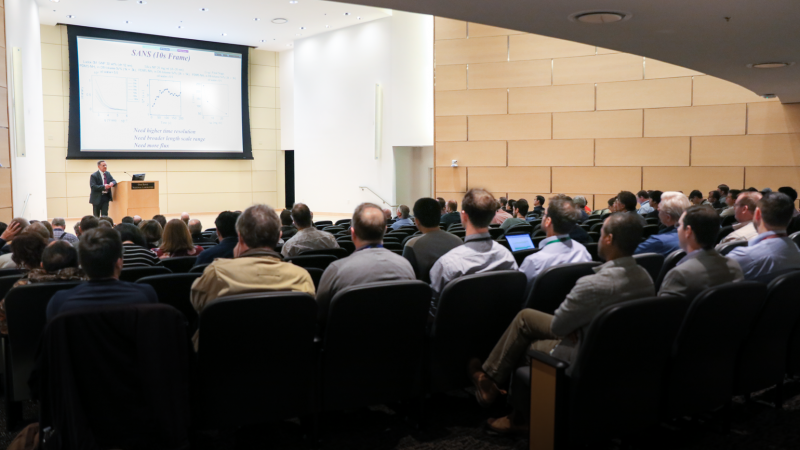Leading neutron science researchers attended the 2-day “Science at the Second Target Station” workshop, December 9-10, at the Department of Energy’s (DOE’s) Oak Ridge National Laboratory (ORNL). The event was held at ORNL’s Spallation Neutron Source (SNS) to encourage scientists to contribute ideas that would help lead to research capabilities and the initial suite of instruments at SNS’ future Second Target Station (STS). Attending onsite or remotely were nearly 300 members of the global neutron scattering community. The workshop featured plenary presentations, a poster session on STS concepts, and multiple breakout sessions covering a broad range of research areas and needs that the STS could help address.

Nearly 300 members of the global neutron scattering community attended the "Science
at the Second Target Station" workshop, either onsite or remotely.
Credit: ORNL/Genevieve Martin
Duke University’s Olivier Delaire and ORNL’s Ken Herwig welcomed attendees and laid out goals for the group during the meeting. “This workshop is about more than promoting the intrinsic strengths and merits of the Second Target Station, it is about advocating for a competitive, world-leading neutron scattering infrastructure at ORNL and pushing the boundaries of science in general,” said Delaire, associate professor of mechanical engineering and materials science at Duke and Chair of the User Group Executive Committee that represents the researchers who benefit from ORNL’s neutron facilities. “Our efforts here should be seen both in an international context, and in a context where science is increasingly requiring multimodal and multipronged experiments—the type the STS will permit.”
In his opening session remarks, Brookhaven National Laboratory’s John Hill explained the need for both neutron and x-ray diffraction facilities, which are complementary in their strengths and weaknesses, and can be leveraged to help solve a given problem. “Joint proposals involving advanced neutron sources, such as the planned STS and advanced x-ray sources like Brookhaven’s National Synchrotron Light Source II, will greatly benefit the user community and increase both facilities’ impact,” said Hill. “A key in making the case for any new source and its instrumentation is to understand the role that the technique can play, together with other complementary techniques, to tackle the science challenges at hand.”
ORNL is moving forward on a conceptual proposal for the STS at ORNL, a third neutron source designed to complement existing neutron scattering capabilities at the SNS’ First Target Station and at ORNL’s High Flux Isotope Reactor (HFIR). The STS will fill existing gaps in materials research capabilities by providing brighter pulses of longer-wavelength (“cold”) neutrons and the latest experimental instruments optimized for exploring complex materials over a wider range of length scales. STS experiments will be complemented by other ORNL capabilities, such as high-performance computing, which can contribute to all areas of research. Together, the three ORNL neutron facilities will ensure the United States maintains global leadership in neutron science, while supporting US industry and universities, military and national security agencies, and the nation’s overall economy.
Paul Langan, associate laboratory director for ORNL’s Neutron Sciences Directorate, said, “Although it’s hard to predict what the research challenges of tomorrow will be, I am confident that the STS will allow researchers to develop new materials that underpin future technologies, such as quantum computing, reusable plastics, new energy conversion and energy storage technologies, and stronger and lighter structural composites. The STS represents a tremendous opportunity to help shape our nation’s future prosperity."
Neutrons are ideal tools for studying energy and materials down to the atomic scale, they can easily penetrate dense materials such as solid metals, and they are non-destructive and sensitive to lighter elements such as lithium and hydrogen. These capabilities, plus their nondestructive properties, make them useful for a wide range of basic and applied research. In addition, the STS will provide many unique capabilities for new experiments, including those that require time-resolved (i.e., “movie”) measurements of kinetic processes, simultaneous measurements of hierarchical architectures across unprecedented length scales, and special environments for exploring new frontiers in materials at extreme conditions.
“The STS’ ability to probe materials over a broad range of length scales, with a smaller beam and therefore with smaller sample sizes, will be very important,” said University of Massachusetts–Amherst’s Tom Russell in his plenary talk on soft matter science at the STS. “Such capabilities will also greatly reduce the time it takes to conduct experiments, such as neutron beam reflectometry, which now can take hours, but at STS would likely take only minutes.” Russell added, “If STS had existed years ago, I could have possibly finished all of my thesis work in a day!”
Extended breakout sessions included topics such as biology, engineering materials and industrial applications, environmental science, fundamental physics, materials discovery and characterization, quantum materials, and soft matter, which enabled specialists in these areas to discuss research capabilities they think should be part of STS’ experiment tool kit.

Extended breakout sessions on neutron scattering in biology, engineering materials and industrial
applications, materials discovery and characterization, and other fields enabled scientists
to discuss research capabilities proposed for the STS. Credit: ORNL/Genevieve Martin
Planning for the design of the STS has come a long way in just a few years, said Philip “Fyl” Pincus, theoretical physicist at University of California–Santa Barbara. “Back in 2014, I helped organize an ORNL workshop on ‘Grand Challenges in Soft Matter,’ and the neutron diffraction capabilities being discussed here this week for the STS are far beyond what we had hoped for,” said Pincus. “Now it seems the STS will be able to deliver even more advanced neutron scattering technologies than we imagined.”
Laura Greene, from the National High Magnetic Field Laboratory (NHMFL), said she is excited about the prospects of an STS instrument capable of performing neutron research in extremely high magnetic fields—targeting the range of 25–35 Tesla. “The proposed instrument, currently referred to as ZEEMANS, would be a versatile, next-generation neutron scattering instrument built around a large vertical magnetic field sample environment,” said Greene. “Not only would such a high magnetic field instrument contribute to maintaining US leadership in the neutron sciences, it would open up new and unexpected avenues of research, including multi-measurement experiments that would leverage the capabilities of both the NHMFL and ORNL.”
One relatively new area of discussion for the neutron researchers was the idea of artificial intelligence (AI), including machine learning and deep neural networks, making contributions to STS science capabilities. “Machine learning and other aspects of AI could eventually automate certain parts of the data analysis process to help eliminate some of the bottlenecks faced by researchers given today’s larger data sets,” said presenter Tony Hey from the Rutherford Appleton Laboratory. “STS could one day become an AI-enabled smart laboratory, combining deep science with artificial intelligence by placing the necessary computing resources next to the beamline to acquire and learn from the data, and be a valuable tool for researchers.”
Specific questions raised about combining AI and deep science (DS) included these: what problems could AI/DS methods help solve in neutron data collection; could STS instruments be designed that are deeply integrated with AI; could potential biases be prevented; and are neutron research data sets large enough for AI/DS to work?
“As the world’s foremost center for neutron research—in fact, 75 years ago, ORNL became the birthplace of modern neutron science—it is fitting that we have so many experts here to continue our success by helping plan the next generation of our nation’s neutron instruments and research priorities,” said John Haines, STS project director.
Graeme Murdoch, associate STS project director said, “Over the next decade, many of the ideas proposed and debated here today will become reality as part of the hardware, software, and infrastructure developed for the STS.”
SNS and HFIR are DOE User Facilities. UT-Battelle LLC manages ORNL for the DOE Office of Science. The Office of Science is the single largest supporter of basic research in the physical sciences in the United States and is working to address some of the most pressing challenges of our time. For more information, visit https://energy.gov/science.—by Paul Boisvert




